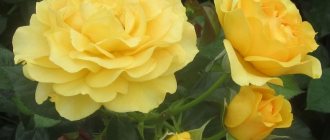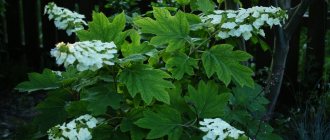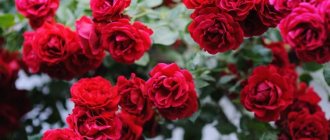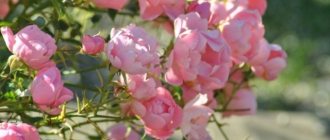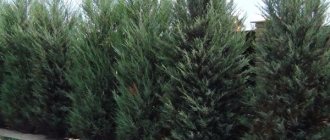Shrub roses or scrubs
Scrubs are considered park roses. They are very impressive, with a varied range of colors. The shrub blooms from early summer until autumn. It is undemanding in care, winter-hardy, resistant to diseases and pests.
Wintering in central Russia does not require additional shelter; in the northern regions it is quite light. Rose bush (Schwab is translated from English as bush) has strong stems two meters high.
Covering rose bushes for the winter
Crown Princess Margaret
The most disease- and frost-resistant English rose with apricot and orange flowers on shoots beautifully curved towards the ground.
Snow ballet
An elegant, airy, delicately scented rose bush with delicate snow-white terry petals forming inflorescences.
Toscanini
A hybrid tea variety with bright red-orange flowers that does not fade in the sun. The height of the bush shoots is up to 1 meter.
There is an opinion about the difficulty of growing this wonderful flower in your garden plot or dacha. But if you choose the right variety that will suit the climatic conditions, growing a rose bush is no more difficult than any other flower. This queen of flowers will decorate any landscape with her presence and will be the best gift for amateur gardeners.
Classification of winter-hardy roses
In addition to the division into varieties and varieties, the division is also carried out into groups. The systematization is as follows:
- First group. True roses have elastic shoots in the shape of an arc. Grows up to 5 meters. The spines are beautiful and thin. The flowering is rich and lasts about a month in the first part of summer. The foliage is small. Representatives are winter-hardy.
- Second group. Created by mixing remontant, tea and hybrid tea roses. The plants are interesting with strong growth up to four meters. They turned out with voluminous flowers and are distinguished by their second flowering. Resistance to cold, partial resistance to disease.
- Third group. Created by changing bush roses with voluminous flowering. They develop rapidly and bear fruit a little later. Bright colors.
Luck of Cordes
Roses of these varieties are sometimes called cordesias, but the correct name of the class comes from the name of Wilhelm Cordes II from the dynasty of German gardeners and breeders who managed to obtain plants that formed the varietal group. Most roses in this group are winter-hardy; they are used to breed new frost-resistant varieties.
Quite voluminous bushes - they can reach 2 m in width and height - are excellent for creating a hedge. The flowers are pink, semi-double (up to 7 cm in diameter), collected in brushes of 10-25 pieces, the leaves are dark green. This variety is known for its excellent frost resistance and disease resistance.
Among frost-resistant varieties, roses of this variety are considered one of the most profusely blooming. The flowers are deep pink (up to 8 cm in diameter) with wavy double petals and form thick clusters. The bush grows up to 150 cm in height and 120 cm in width.
This climbing rose, bred in 1955, was considered by its originator Wilhelm Cordes to be his best creation. And quite rightly so. Winter-hardy and hardy, immune to
, capable of delighting with its lush flowering for more than a month. It blooms profusely with bright red flowers with a scarlet sheen, collected in bouquets of inflorescences of 5–7 pieces.
In the garden classification of roses, it occupies a special place that belongs only to it. It belongs to the once-blooming variety, but cannot be considered a classic rambler. There is no need to remove faded shoots, as they will bloom again next year. It fits quite easily under cover and confidently withstands even the most severe frosts. It has been noticed that it lives longer as its own root, so it is better to propagate it by cuttings.
An amazing scrub from 1969, a uniquely beautiful rose with bright semi-double cupped flowers. The complex color as it blooms changes from fiery orange to salmon pink. The golden yellow center of the flower glows from within. The edges of the petals are wavy, which gives the rose grace and unique charm.
Rose 'Westerland'. Having this outstanding variety in your garden is a great success! Photo by the author
A lushly blooming rose, bred in 1977, with large, densely double (each flower has up to 100 petals and a tiled structure) bright pink flowers with a silvery bloom, collected in heavy drooping clusters. The leaves are glossy and disease resistant. Spreading bushes with whip-like shoots.
A bright representative of the romantic trend in rose breeding, it is now at the peak of popularity, although it was introduced to the world of gardeners back in 1984. It blooms with caps of small carmine-red cup-shaped flowers with a pale pink center. Not afraid of heat or rain. A beautifully leafy bush up to 1.5 m high resembles a pink cloud.
'Angela' is a bright representative of the romantic trend in rose selection. Photo by the author
Climbing roses bloom all summer, winter-hardy varieties
There are two key characteristics by which the division occurs: small-flowered and large-flowered.
Roses with small flowers are called Ramblers. Their difference is in thin and plastic shoots. They appear in early summer with small and primitive flowers. Flowering occurs once on last year's branches; this should be taken into account when pruning and covering.
Ramblers are quite unpretentious; they bloom all summer and are winter-hardy. These include:
- Bobby James. The best among small-flowered representatives. Up to eight meters in height, up to three meters in width. The foliage is green, but with abundant flowering it is practically invisible. Roses are creamy white, up to five centimeters. They emit a musky aroma. The variety is frost-resistant and disease resistant. Suitable for the Moscow region.
- Super Dorothy. Height up to 2.5 meters. The foliage is small. Late flowering, but rich and repeating. The variety is resistant to diseases, the flowers last until the onset of cold weather.
- Rambling Rector. It can reach more than seven meters in length. The color is pink, but gradually turns white. Roses are resistant to diseases and low light.
- Dortmund. Up to three meters long. The flowers are up to nine centimeters in size. The smell is not strong. Frost-resistant variety.
- Snow Goose. A sturdy and attractive creation. Height is more than three meters. The foliage is dark, with a small number of thorns. Flowers up to five centimeters, blooming all season almost uninterruptedly and abundantly. Resistance to diseases and frost.
Snow-Goose
The second group of Climings are climbing roses with strong, thick and hard shoots. Bred by crossing. Repeatedly, abundantly and for a long time blooming varieties on the shoots of the current year and previous years. The flowers are large and some have an intense aroma.
Claiming varieties:
- Michael (Orfeo). The buds have a chic dark color. The petals are velvety with a refined scent that becomes stronger in cool weather. The foliage is sparkling, dense, large. Resistant to diseases, but sensitive to rain. Flowering occurs continuously from June to October inclusive.
- Handel. The first re-blooming climber. With dark pink edging. The waviness of the flower adds sophistication. Inflorescences of 3-9 pieces are formed. Most beautiful when half-bloomed. Flowers are modified depending on weather conditions. Among roses, this variety has the most beautiful color contrast.
- Elf. Height up to 2.5 meters. Vigorous plant, large foliage. The flowers are greenish-white. Size up to fourteen centimeters. Fruity aroma. Resistant to rain and disease.
- Polka. A special rose. It is grown in two ways: as a low climber, or as a large, arched scrub. The buds are a concentrated apricot color, to creamy at the edges, the base is darker, which creates a play of colors. Flowering occurs repeatedly. Disease resistance. Variation in the appearance of roses depends on climatic conditions. It can reach three meters in height. The smell is not strong.
- Rimos. They have a colorful yellow color, turning lemon-colored in strong sun. Golden stamens are visible in the flower. Flowering is abundant and lasts until cold weather.
- Gloria Day Clyming. The flowers are yellow, not intense, with a pink edge. Up to 15 centimeters. The flowers have a weak, pleasant fruity aroma, solitary. Goblet shape. The plant can reach those meters. The foliage is dark and green. Flowering is medium, repeating. Winter-hardy.
- Golden Perfum. Rose with voluminous buds, twelve centimeters. Fragrant and rain resistant. They have a rich yellow color, enhanced by red stamens. The plant is branched, up to three meters. Flowering manages to repeat twice. This variety is one of the most famous among climbing roses. Flower in the shape of a cup. Flowers bloom slowly, making the owner happy for a long time.
- Parade. The variety is suitable for small-sized gardens. The flowers are large, concentrated pink or cherry red, cup-shaped, and the bushes are not particularly tall. Resistance to rain and frost is average. Rich repeat blooms.
- Schwanensee. A sought-after hardy variety, systematically flowering and resistant to rain. The flowers are voluminous, white with a slight pink tint. Looks great on a bush with bright green foliage. The buds have a standard appearance, elongated shape. The flowers open slowly. Diameter seven to eight centimeters. As a rule, there are no more than three of them per shoot. Flowers exude a delicate aroma. Flowering is long and repeated.
Varieties of semi-climbing cordes roses:
- Flamentanz. An actively blooming rose with a picturesque crimson color. Flowering occurs once, but can last up to thirty days. Diameter is about eight centimeters. Roses are found in inflorescences of three to sixteen pieces. Excellent winter hardiness is excellent for growing in Siberia. The plant is resistant to the most important diseases.
- Sympathy. Winter-hardy hybrid. Flowers with a tall glass, concentrated red color, with dark reflections. The first bloom is abundant, repeated blooms are weaker. The plant is resistant to rain, wind, and diseases. Up to four meters. The flowers are large and have a cup-shaped appearance.
- Westerland. The plant has strong disease resistance. The flowers are large, wavy. There are 5-10 pieces in brushes. Flowering begins early, but repeats itself. The foliage is elongated and dark. The bush is prickly. But the plant is beautiful.
Important! Regardless of the variety, any climbing roses require maximum attention, especially in the first year of cultivation.
The best varieties of climbing roses:
- Iceberg. One of the common types. The size of the flowers is up to eight centimeters. They bloom in inflorescences of three to eight pieces. The color is white, the aroma is subtle. Roses bloom all summer until late autumn. Excellent as a hedge.
- New Dawn. The size of the flowers is up to seven centimeters, in inflorescences of five to seven pieces. In rare cases, solitary. The color is soft pink, the aroma is not strong apple. Up to two meters high. Resistant to fungal diseases.
- Paul with Scarlett Clymer. Flowers up to seven centimeters. The color is concentrated red, the smell is slightly noticeable. Height is more than one and a half meters. Flowering occurs in the middle of the first summer month and lasts approximately for thirty days. After a short break, re-blooming begins. The plant is resistant to fungal diseases.
- Orange Morsdang. Low bushes, flowers up to five centimeters. Flowering is almost continuous. Does not tolerate rain well, has average resistance to diseases.
- Flamentanz. An unpretentious and winter-hardy rose. Rich flowering. Great resistance to diseases. In the first year the plant does not bloom.
There are many varieties. It is important to have an idea of their distinctive features, because this determines what the development needs will be and how to properly provide proper care, pruning, flowering, thorny or non-thorny plants.
During this time, the range of varietal roses has increased. Kordes are one of the best. They stand out for their special beauty and are characterized by abundant and long-lasting flowering. Excellent health and resistance to frost, easily overwinter.
Harkness are known everywhere. They are reliable in this they have no equal. Roses are unpretentious and easy to care for. Therefore, this is an ideal option for beginner gardeners. Repeated flowering, winter-hardy.
Roses from Tantau have appeared relatively recently. The plants are charming, bloom all summer, and tolerate rain well.
Climbing roses are in demand among gardeners. They have thin, long shoots that need support; they are irreplaceable for landscaping. Their sizes are not difficult to control and easily fit into different environments.
Kordes
Tantau
Maiden grapes
An excellent way to hide from the heat is a plant with such a gentle name. Its thick green foliage, covering the gazebo, will give refreshing coolness and create a comfortable mood. Flowing stems can climb a ladder to a height of up to twenty meters.
In summer, the leaves of the vine are covered with a rich green color. In autumn, the leaf cover becomes an incredibly beautiful bright purple color, against which the berries glisten with bluish-black beads.
ATTENTION! The berries are poisonous.
This plant has a lot of advantages, but it also has certain disadvantages.
For those who want to surprise others with a variety of landscapes, annual species of loaches are suitable: morning glory, sweet pea, kobeya.
Climbing rose: care, pruning work in spring
- With the onset of warm days (early-mid March), cover the exposed surface of the winter frame shelter from the frame and the rose bush itself with snow. This will help protect flowers from spring temperature changes during the day and night.
- After 2 weeks, remove the remaining snow, draw a groove to remove melted water
- Perform daily 20-30 minute ventilation, opening the shelter on both sides
- When it becomes much warmer and there is almost no snow left, begin preparing for the full opening of the plant. To do this, open one or two sides of the shelter for ventilation. Next, throw on the covering material, leaving a small opening so that the flowers can breathe.
- After a week, free the roses from the protective material from the east or north, at your discretion.
- After a couple of days, you can completely open the bushes and remove the leaves from the soil.
- Now we do cosmetic pruning, removing broken, dried out or damaged by cold branches to the whole part
- Next, we irrigate against infections with copper oxychloride or copper sulfate.
- Hill up and cover with spruce or thin agrofibre, lutrasil or fabric
- With the onset of stable above-zero temperatures, and in the absence of the risk of night frosts, we do the main pruning, giving the desired shape to the bush and removing weak shoots
- We immediately treat diseases and pests with the same copper sulfate
- We make fertilizing from a warm infusion of mullein 1:10, calculating 10-15 liters per bush
Expert opinion on growing climbing roses
“Gardeners often share the opinion that roses purchased for growing on supports do not behave like climbing roses: they do not gain mass well, and even for several years they do not achieve the growth stated in the characteristics. How can this be explained?
First of all, of course, the climate of the region where the rose is grown, the composition of the soil, care
In addition, attention should be paid to the following things:
- You can provoke high growth of the bush by correct placement on the support. Here you can use the method of horizontal arrangement of the main lashes, then the shoots of the second order will grow with greater force and tend upward. A spiral garter is also suitable; the second-order shoots that appear will also continue to wrap around the column higher and higher. The support must be at least 1.8 m. Bases in the form of huts, pyramids and similar shapes are not suitable for roses.
- As a rule, after flowering it is recommended to trim the brushes into rings. Therefore, in pursuit of active growth of the bush, it is necessary to artificially curtail the process of bud formation. This will allow you not to trim the lashes, maintaining the length they have reached for the next season, and will also give more strength for growth itself.
- Well, and mandatory regular watering and fertilizing, depending on the weight of the bush.” (Andrey Vladimirovich Tkachenko, expert).
What roses bloom all summer: photo, description
Continuously blooming roses begin their active growth in late May - early June. This process lasts throughout the summer and continues into the fall. This feature is an undeniable advantage over varieties that bloom only once. Despite this, people plant other types of this beautiful, beloved flower.
Roses that bloom constantly (all summer and autumn) most often belong to the following groups:
It should be noted that practically all varieties from the polyantha group have a high degree of resistance to various vagaries of weather, diseases and pests. They are also distinguished by abundant, continuous flowering. Also, polyanthus roses are unpretentious and can grow in any region, regardless of soil and climatic conditions.
What roses bloom all summer? Photos and descriptions are presented below:
- Arctic Fire (Arctic Fire). A very fragrant ground cover plant with incredibly beautiful snow-white flowers. The low bush (about half a meter) blooms profusely in early June and this process continues until the end of September. The petals are terry and delicate. They love warmth, so it is recommended to plant them in sunny areas without shading from any buildings or plants.
- Avila Palace (Avila Palace). These are very beautiful roses that bloom all summer (see photo). The rich light red hue of the buds fits very harmoniously into the landscape design of the country courtyard. The plant belongs to the floribunda group. In order for roses to bloom all summer, it is important to choose a sunny place in the garden, since they are very demanding of constant consumption of sunlight. The bush is relatively low (up to 1 m in height). This variety also requires constant care; fertilizers should be applied on time and the necessary pruning should be carried out.
- Bonica 82 (Bonica 82) . Another representative of polyanthus roses. The main feature is abundant and long flowering, right up to the first frost. These are unpretentious roses that bloom all summer. They do not need special care, and they are not particularly picky about the planting site and the soil in general. The only element of care is the obligatory pruning of the bush for the winter. Today, Bonica 82 is one of the most sought after continuously flowering rose varieties in the country.
- Aquarell (Watercolor). They belong to the hybrid tea varieties of roses that bloom all summer. You can buy this beautiful plant at any flower shop; it is quite popular. During the blooming process, the flower changes many shades (from light red to cream), especially during budding. Their centers are almost always deep yellow. The flowers themselves are very large (up to 13 cm in diameter), the petals have a complex structure. The bush is relatively low, just over 70 cm on average. It is practically not affected by black spot, late blight and powdery mildew. Florists often use similar varieties of roses, which bloom all summer, to create bouquets and various compositions, as well as in landscape design.
- Iceberg (Iceberg). What varieties of roses bloom all summer? This question is often asked by amateur gardeners. Experienced florists offer Iceberg. What does the name say? It should be noted that the plant has very beautiful snow-white flowers that bloom all summer and until mid-autumn. Shoots can reach up to 3 m in length. They decorate arches, windows, walls. This is the most popular climbing rose, blooming all summer.
Plants with long stems and small flowers
If we consider this group of roses, then the positive qualities include the rather spreading growth of the stems, which are ideal for decorating a personal plot and fences. Although they cannot please you with large buds, the maximum size of which does not exceed 5 cm, they conquer them with a large number.
Super Excelsa is an unpretentious and very hardy variety, which is most often planted along paths and near fences, since the stems cover an area of no more than 4 square meters. These roses prefer shade; in the sun they quickly lose their bright fuchsia shade.
The Snow Goose variety is ideal for decorating vertical surfaces or creating a beautiful flower carpet on a designated area of land. The plant's brushes are composed of white lush buds, the number of which can reach more than 20 pieces. The flowering of this variety can be observed all year round without interruption, and the plant does not require special care.
Super Dorothy is a hardy perennial plant that blooms in late spring and can bloom until the first frost. Super Dorothy with crimson flowers is most often found, but there are other shades of buds.
If you need to plant roses that bloom all summer, and at the same time withstand winter well without special shelters, then you should choose Rambling Rector. In addition to its high tolerance to cold and heat, this variety is distinguished by its unusual buds: immediately after the rose blooms, it has an ivory color, but literally after a few days the color changes to dazzling snow-white. The racemes can contain up to 50 flowers at a time, and the stems reach 5 meters in length.
Constantly blooming climbing rose: the best varieties
Perennial shrubs: winter-hardy, flowering
These include the following varieties:
- Avila Palace;
- Iceberg is a floribunda that looks impressive due to its luxurious long branches;
- Faya Lobby climbing;
- Prairie Joy - roses of Canadian selection;
- Coral sunset.
Avila Palace
The abundance of varieties allows each gardener to choose the variety that will look best on the site.
Shrub roses
An area with bush roses always looks unusual, cute and cozy. After all, there are not many ornamental plants that are distinguished by the variety of their colors, the shape of their inflorescences, long-term flowering and excellent aroma. Therefore, this variety of roses is ideal for gardening and landscape design. By growing species with different flowering periods and different colors, you can form original compositions from shrub roses. In addition, single spreading bushes planted in the center of the nursery also look great.
Specimens of this category are branched shrubs, reaching two or more meters in height and having semi-double or double flowers. Such varieties are similar to cultivated rose hips, but with regard to the color palette, size and degree of doubleness of the inflorescences, in this they are significantly superior to it. The same can be said about the duration of flowering. Some varieties of these roses bloom once during the season, others delight with their appearing flowers repeatedly during the summer period.
Shrub roses are distinguished by dense and, one might say, continuous flowering until frost, resistance to fungal diseases, high humidity and low temperatures. They grow too quickly and have strength and endurance, and they are also almost picky. Therefore, they are planted for their winter hardiness in gardens located in regions with harsh climatic conditions.
Rose varieties for different regions
It is impossible to give an example of rose varieties that are most suitable for a particular region within one article. Therefore, below we will describe the most common ones, due to their aesthetic qualities, as well as their high level of viability.
Large-flowered roses
An erect bush with large bright red flowers covering it from the base to the top. It is grown both on a support and in the form of a scrub. Flowers last a long time and are not afraid of strong winds or rain. The variety is characterized by high resistance to diseases, as well as frost resistance. And, although the rose is recommended for cultivation in zone 5, it also shows its qualities well in regions above this zone. For example, it feels great in garden plots in the Moscow region and Leningrad region.
The rose is the brainchild of the Krodes nursery, and has all the stability criteria typical for varieties of this company: frost resistance, strong immunity, immunity to rain and winds. At the same time, it is distinguished by its decorative nature, having adopted the beauty and elegance of the flower from hybrid tea roses. The color is classic red. The bush is tall, branched with bright green foliage with a glossy surface.
Both varieties are repeat bloomers and have a weak aroma.
This variety, according to reviews of many gardeners, occupies one of the leading positions in resistance to adverse conditions.
Another representative of the Kordes nursery. The bush is distinguished by positive growth energy and endurance. It blooms once with ruby-colored inflorescences on last year's canes. This variety is widespread in the Northern regions due to its unpretentiousness and winter hardiness. Tolerates climates with short summer periods. It grows well even in partial shade. It is recommended to grow with a support, or behaves like a ground cover rose. It has good immunity, but in some cases after flowering it is affected by black spot.
It is considered the most sought after rose, as it shows a high degree of endurance both to the cold season and to diseases. It can be grown as a cascading bush, but with sufficient support it performs well as a climbing rose; the length of the vine can reach 5 m. The flowers are soft pink, in hot weather they become almost white, with the smell of exotic fruits. From the moment of dissolution, the inflorescence does not last long, but this is not noticeable against the background of the abundance of flowers. Refers to re-blooming.
Small-flowered roses
This variety belongs to the group of ramblers that can bloom more than once per season. The vines are pliable, form well along the support, but under the weight of the flowers they bend down, creating a “weeping” effect. Each brush consists of 20-40 buds, which bloom gradually. Therefore, although the flowering begins later than other roses, it pleases without interruption until frost. The flowers are pale pink. Resistant to diseases, rain, frost.
The popularity of this rose around the world is gaining momentum every year. Thanks to its endurance and unpretentiousness, it deserves a place among
This rose blooms later than others, but the flowers bloom until the frost.
a list of varieties that are worth planting, even for beginners in this matter. Pearlescent pink inflorescences, with a simple but elegant flower shape, leave no one indifferent. Tolerant of both heat and rain. It tolerates the winter period well, but, for example, in the Moscow region and higher regions it will need shelter. If you refer to reference books, this rose is not a climbing rose. But, according to the experience of gardeners, under favorable conditions it grows well and can reach 2-2.5 m.
Application options for climbing roses
In home gardens, climbing roses are used for various purposes. Plants are suitable as unusual garlands and pyramids, for creating an arch of climbing roses or for decorating a gazebo. It will also look great when landscaping an arbor, fence or column and many other buildings. Roses will help create a gorgeous look.
There are also other, original options for using these plants. If you plant climbing roses near trees or strong bushes, then in the near future they will begin to use them as a support. In such situations, careful care and pruning are required. In addition, the tree can easily overcome such a neighborhood, and the bushes may die. Before using a plant as a support, you should make a thoughtful decision.
Types of climbing roses
For landscaping arches, pergolas, gazebos, and forming living walls, rose varieties that need support are used. This may include:
- ramblers;
- climbers.
This is where the initial choice needs to be made. Because these two groups differ in some of their properties.
Ramblers are truly climbing roses with fairly flexible shoots that are easy to guide along a support. They bloom once. In addition, they are easy to lay on the ground under cover in the fall. They require minimal pruning, or rather, only sanitary pruning, since they bloom mainly on shoots from previous seasons. But this is precisely why they need protection for the winter, even despite the high ratings of the winter hardiness of the variety. It is important to preserve young canes for flowering in the next season. It will be enough to make a light air-dry shelter. If they are left to overwinter, relying only on their own strength, then the shoots that have frozen over the winter will have to be removed and in this case the flowering will be scanty, only on the surviving branches. Today, there are young varieties related to ramblers that bloom repeatedly.
Winter-hardy varieties of other classes
Of course, the longest-blooming roses are not necessarily representatives of the well-known groups of varieties that we described above. Here are a few more interesting varieties for your attention, which can also surprise you with the duration and beauty of flowering.
This unusual plant belongs to the group of Chinese rose hybrids. The green color of the petals may not be appreciated by everyone, but how original these neat branched bushes (100 cm high and 80 cm wide) look on the site! The flowers are small (5-6 cm) with pale pink spots. Viridiflora roses are also often used as a basis for bouquets.
A variety from the Miniflora group, or Patio. The neat bushes of this miniature semi-climbing rose reach 40 cm in height and bloom with small double flowers of a soft pink color. It grows excellently both in flowerbeds and in containers and has a pleasant aroma.
This variety (registered in 1999) can be recommended as completely problem-free, healthy and highly decorative. The bush grows in a ball up to 50 cm in diameter, the leaves are shiny. Against their background, bright raspberry-red dense inflorescences of small flowers that do not fade in the sun and are not afraid of rain look great. Blooms continuously until late autumn.
'Gartnerfreude' is a highly decorative, unpretentious variety. Photo from 1decor.org
Rose 'Palmengarten Frankfurt' blooms continuously all summer long. Photo by the author
Year of registration - 2003. The rose is distinguished by its exceptionally good health and high decorative value throughout the entire season. Densely double (up to 100 petals) flowers are intensely pink in color, fade a little, but are resistant to rain. Experts advise not to trim too much. Suitable for creating continuously flowering borders both in rose gardens and along paths.
Meillan rose 'Les Quatre Saisons' - the name itself speaks of its continuous flowering. Photo by the author
Introduced to gardeners in 1978. Blooming profusely with pure white flowers in drooping clusters, the rose is considered one of the best among the varieties of Meyyan selection. A low spreading bush with small, beautiful dark green foliage.
Paul's Scarlet
- Paul's Scarlet is a variety of rambler, that is, a once-blooming climbing rose.
- New Dawn is a climbing rose of American selection.
- The Fairy - has good winter hardiness and excellent landscape qualities.
- Flammentanz - this variety is distinguished by its frost resistance. The flower can be successfully placed under cover, as a result of which it will withstand even very severe frosts.
- Westerland is a great scrub. Tolerates winter very well.
- Rosarium Uetersen - is distinguished by lush flowering before the onset of frost.
- Hansaland variety of wrinkled rose. It tolerates wintering without problems and with virtually no shelter.
- Rose Angela - has excellent endurance. She is not afraid of either rain or heat. Frost is also not terrible for this flower.
- Gloria Dei is the world's most famous cold-resistant hybrid tea variety.
- Pierre de Ronsard, also known as Eden Rose, is a spectacular climber. Has good winter hardiness.
Ramblers (small-flowered roses)
Plants of this group form long, thin, arch-like shoots, ranging from 3 to 15 meters in length. The formation of flowers occurs on the shoots of the previous year, so it is necessary to cover roses especially carefully for the winter.
The flowers are small, up to 3-4 cm, of various colors. Typically, rambler roses have little or no scent, but this is compensated by their abundant blooms.
Almost all varieties of the group bloom once, forming flowers along the entire length of the stems. Ramblers are valued for their unpretentiousness, frost resistance, and ease of organizing wintering of plants.
Super Excelsa
A variety from the ramblers group, characterized by long flowering. The bush forms shoots up to 3-3.5 meters, the width of the bush is up to 2 meters. The formation of flowers occurs along the entire length of the stems, so the leaves of the plant are often not visible due to the number of flowers.
From 3 to 10 flowers are formed on one shoot. The diameter of the roses reaches 4 cm, the color is raspberry-red.
Flower growers in the Moscow region note Super Excelsa's high resistance to black spot and powdery mildew.
SnowGoose
Incredibly beautiful, as if sprinkled with snow, the blooming Snow Goose rose bush attracts everyone's attention. Small dense flowers are collected in large brushes, each with a diameter of up to 4 cm. There are up to 20 flowers in a brush. The color is pure white.
The shoots of the bush grow up to three meters in length. The plant is vigorous, branched, with shiny small dark green foliage. There are few thorns.
The variety is used for vertical decoration of supports, suitable as a ground cover rose. Resistance to infections and sub-zero temperatures is high. In the middle zone, Snow Goose is covered for the winter.
Rambling Rector
A popular variety from the ramblers group, it was first presented at a nursery in Newry (Ireland). On the vigorous shoots of the plant, many semi-double small rosettes of creamy white color are formed. The diameter of the flowers is up to 3-4 cm. The aroma is weak, with a musky note.
In the climatic conditions of central Russia, lashes grow up to 3.5 meters, in the south - up to 5 meters. The leaves are small, pale green, beautifully shaped.
Flowers are collected in inflorescences of 15-50 pieces. In the sun, the petals quickly fade, acquiring a pure white hue. The variety takes good cuttings and is often grown as a shrub.
Bobbie James
It surprises with lush flowering and a strong pleasant aroma. Belongs to the group of ramblers with white flowers, forms many inflorescences-tassels. There are 6-15 flowers in one brush.
The bush is vigorous and requires a fairly large area for cultivation. Bobbie variety blooms once, usually from mid-June to late July or early August, and is suitable for decorating gazebos, arches, pergolas, building walls, and fences.
Advantages of the variety:
- frost resistance;
- high immunity to diseases;
- easy care;
- unpretentiousness to nutrition and soil types;
- resistance of flowers to fading and precipitation.
The Bobbie James variety from English breeders has been successfully grown by flower growers in the Moscow region for many years.
Super Dorothy
Of the re-blooming ramblers, the favorite of midland gardeners is the Super Dorothy variety. Brought out in Germany, it is characterized by increased winter hardiness and resistance to infections.
The bush is spreading, with thin thornless shoots up to 3-4 meters long. The flowers are small, pompom-type, collected in brushes of 20-40 pieces. The color is bright crimson.
On a note!
The flowers of this variety fade in the sun, so it is advisable to provide light partial shade.
Flowering begins late, but continues until the cold weather. The shoots are soft and pliable, so the Super Dorothy variety is suitable for decorating any supports and structures. Due to its increased resistance to sub-zero temperatures, the variety overwinters well in the Moscow region; shelter is not required in mild winters.
Pests and diseases of climbing roses
Powdery mildew. This disease is caused by a fungus. It appears on the leaves in the form of white spots that increase over time. Forms well in hot and humid conditions in late summer. The plant itself stops growing and stops blooming. Which could ultimately lead to his death. To prevent the disease, experts recommend spraying the bushes with Bordeaux solution.
Conitirium - bark cancer. Symptoms when releasing bushes from winter shelter. Red-brown spots appear on the bark; as they grow, they begin to turn black and can cover the entire shoot. The infection is located internally, so infected shoots must be quickly cut out, including healthy shoots, and then immediately burned.
This mushroom grows quickly in the dark under cover. As a preventive measure, nitrogen levels are reduced in the fall, tissue feeding, shelter at the appropriate time and ventilation when necessary, and material removal. Removal and extermination of damaged areas. In addition to them, the plant can be affected by aphids and spider mites.
Planting and care
Climbing roses - varieties of permanent flowering - prefer sunny areas located on the south side. Thanks to good lighting, the development of growth is accelerated, and already next summer after planting, abundant flowering can be observed. It is unacceptable to plant young plants in lowlands, as roses do not tolerate stagnant moisture.
Important! In cases where flowers are planted for the purpose of decorating an object, it is best to plant a seedling 50 cm from it.
Experts advise planting bushes in the spring months at sunset. In autumn, seedlings do not have time to adapt and most often die.
Continuously blooming varieties of roses will decorate the area and do not require complex care.
Planting process:
- First of all, the holes are prepared, the size of which should be within 50x50 cm.
- The prepared hole is filled with water.
- The seedling is planted in a hole, which is filled with soil and compacted. If you trim the above-ground part of the plant by 15 cm, you can be sure of rapid growth and rich flowering in the future.
Important! If you still need to plant a bush in the fall, it is best to do this in September, when the rose has time to take root, but does not begin to grow.
In the following years after planting, the seedlings do not require complex care, but it is important to carry out in a timely manner:
- bush pruning;
- watering;
- application of fertilizers.
Pruning shrubs allows you to give the plants the desired shape. It is recommended to water roses every 7-8 days, and add organic matter and minerals to the soil as top dressing.
Note! Plants are planted at a slight slope to the support. If planting is carried out near the house, such a distance should be provided so that the water that will drain does not collect at the roots.
Semi-climbing varieties
We recommend that you read
These varieties of roses are distinguished by strong shoots, so they can grow even in places where there is no special support. They reach a height of 3 meters. Large and densely planted flowers cover the entire bush, covering the leaves and stems with colorful buds. We should briefly consider the most common varieties of these roses in our area.
Semi-climbing roses of the Flammentanz variety have long stems decorated with double flowers of a crimson hue. Usually the size of the bud reaches 8 cm, but you should not expect a heady aroma - there is practically none. This variety is an annual, then it is pruned and new flowering shoots are awaited.
Golden Gate features clusters of yellow flowers with velvety petals. With a good location of the bush, the flowers can be 10 centimeters in size, and the bush itself grows up to 4 meters in height.
The flowers of this variety of roses have a unique, strong fruity scent, but the bush requires some care, especially in the winter season. It must be carefully wrapped to preserve the shoots until the next season. In addition, the plant is susceptible to attacks by pests, which, with insufficient attention from the owner, can lead to a lack of flowers and even death.
The Sympathie variety, unlike the previous one, tolerates negative weather factors very well, grows quickly and blooms profusely. The buds of this type of rose have a bright red color and vary in size for each flower in the cluster. The bush can reach 3 meters in height and up to 2 meters in width. There is only one drawback of this variety - flowering will decrease every year, so you need to periodically replant the bush to renew it.
If you want to have an unpretentious plant in your garden that can easily tolerate any negative factors, then you should pay attention to the Ilse Krohn Superior variety. In addition to its very great endurance, the bush will delight you with milky flowering all summer, right up to frost.
Very rarely does a rose grow to a large size, but this is compensated by huge buds with a diameter of up to 15 centimeters.
Another variety of hardy semi-climbing roses is Laguna. The variety is distinguished by velvety pink buds in the shape of brushes, which exude a persistent floral aroma. This perennial plant does not require special care throughout the year, except for winter wrapping.
Varieties for the Middle Zone
Snowy frosty winters with temperatures from - 8 and below, warm humid summers up to + 22 degrees. The climate is characterized by snowy, frosty, long winters; long spring with frosts; hot but short summer and rainy autumn.
The soil is soddy-podzolic, moist. Common soils are soddy-podzolic, not waterlogged. They are not fertile, low in nutrients, acidic. They need fertilization and normalization of acidity levels.
Suitable for cultivation are decorative varieties of unpretentious climbing roses that will withstand harsh natural conditions, are frost-resistant, easy to care for, and with high growth of new shoots.
Erinnerung an Brod
The rose bush with such a complex name has beautiful inflorescences. Abundant flowering of double buds with a rich aroma. When covered, it can survive 35 degree frost. The shoots reach a height of 2.5 m and a width of 2 m.
Advantages:
- frost-resistant;
- fragrant;
- re-blooming
.
Flaws:
- low lashes;
- requires winter shelter.
Average price of a seedling: 2 years. — 430 rub.
Rosarium Jutersen
Belongs to climbers, a common upright growing shrub. Strong, stable lashes reach 3 m in height. During the flowering period, the rose bush is dotted with large cup-shaped flowers, up to 12 cm in diameter. The color of the petals is deep pink, with a light pearlescent coating on the reverse side. Flowering begins in early summer, with repeated periods continuing, and is accompanied by a pleasant aroma.
Advantages:
- frost-resistant;
- strong shoots;
- grandiflora;
- fragrant.
Flaws:
- hard shoot trunks;
- requires shelter in winter.
Average price of a seedling: 2 years. — 450 rub.
Mermaid
This variety is unpretentious to living conditions and is ready to please its owners even in shady places. With good shelter, it will safely withstand medium frosts (up to -23 degrees). The inflorescences are large, up to 10 cm in diameter, yellow-cream in color with bright orange stamens surrounded by leaves of a beautiful rich green color. The continuous flowering of the shrub is accompanied by a light aroma.
Advantages:
- continuous flowering;
- unpretentious;
- large flowers;
- beautiful colors of leaves and petals.
Flaws:
- average winter hardiness;
- requires careful shelter.
Average cost of a seedling: 4 years. – 480 rub.
Lawrence
This representative reaches a volume of up to 2 m and a height of 5 m. Rare leaves do not cover thorns located on flexible vines. To increase the amount of greenery, it is possible to place green-leafed plants next to each other. The petals are semi-double, yellow in color, collected in clusters of up to 7 pieces. Early flowering is accompanied by an aroma that suits everyone.
Advantages:
- high;
- early flowering;
- volume;
- frost-resistant.
Flaws:
- thorns;
- single flowering;
- requires winter shelter;
- aroma.
Average cost of a seedling: 3 years. – 350 rub.
Dortmund
This representative of the pink display has bright red flowers with a white center and yellow stamens. Quite large, reaching 12 cm in diameter, they literally dot the entire bush. You can enjoy flowering from June to September. Beautiful emerald-colored leaves cover stems reaching 2 meters in height.
Advantages:
- fragrant;
- large flowers;
- re-blooming;
- immunity to diseases;
- frost-resistant.
Flaws:
- requires winter shelter.
Average price of a seedling: 3 years. – 650 rub., 4 years. – 1200 rub., 5 years. – 2500 rub.
Why the climbing rose does not bloom: reasons
- Painful lesions - any disease weakens the garden crop, which interferes with the development of beautiful flowering.
- Wild shoots - many shoots appear as the flower grows along the root area. Untimely removal of which contributes to a decrease in the vital activity of the plant. Over time, the rose grows wild and stops blooming.
- Improperly prepared winter shelter - the lack of free space between the protective film and the seedling itself contributes to the formation of moisture during the warm period of time, which has a detrimental effect on the formation of buds, as well as sub-zero temperatures
- Excess nitrogen supplements - this fertilizing activates the growth of the green crown of the plant, which interferes with the setting of inflorescences.
- Incorrectly chosen planting location - the rose does not like drafts and shading. This can not only lead to a lack of flowers, but also completely destroy the plant.
- Inappropriate pruning – Excessive pruning can result in the removal of young shoots. The plant will not have time to recover and naturally will not form buds.
- Poor soil composition is an important factor on which the entire growth and condition of the rose depends. We choose soil that is fertile, loose, and contains useful microelements.
How and when to properly cover climbing roses for the winter?
- For regions with warm climates, a simple shelter on a support post is suitable. We place spruce branches on the ground according to the diameter of the plant’s growth or secure it to the branches with a rope. Next, we insulate the structure with lutrasil.
- In mid-latitudes, a more thorough method of protection will be required:
- Without waiting for a strong cold snap, we remove the branches from the supports and bend them to the soil. There are types of roses that have a tight trunk; we bend it in stages, fixing it with iron staples. The tops of seedlings should not be allowed to come into contact with the ground.
- Plants that have grown too wide in randomly selected areas are tied with a rope, preventing the needles from injuring the stems.
- You can make a detachable frame, placing it next to the branches. A support is created above them, which is covered with film.
- A simple way to preserve plants is to bend the stems to the soil, secure them with rope and insulate them with a layer of fir legs. We put insulation on this structure.
- It is good to hide bushes arranged in a row in a structure made of plywood blocks no higher than 80 cm. Flower vines hidden in this way do not come into contact with the ground or tree, which minimizes infection. We install the fence in the warm season, secure it with stakes and cover it with polyethylene or other moisture-proof fabric. The main thing is that the seedlings are not wet at this time. We close the sides of the huts with the onset of constant cold weather. This method allows roses to withstand -8°.
- A layer of roofing material will help protect you in the cold winter. The presence of a decent snow layer on the shelter makes it possible to maintain the temperature in the structure at least -10°. At above-zero temperatures, there is access to opening and ventilation from the side of the structure.
- Separately, we construct a three-dimensional frame in the form of a rectangle for the growing bush, this promotes free air circulation inside the structure. Using lutrasil, roofing felt, we insulate the structure, the edges of the covering material are fixed with a layer of earth.
Climbing roses in landscape design: photo
Flower pyramids along the garden alley
Living vases
Tall arch made of climbing roses
A design of extraordinary beauty
Delicate Polka in the interior of the site
Unusual design of a garden wall with fresh flowers
Thanks to the huge assortment of varieties of climbing roses, by organizing appropriate care, you can change the decorative decoration of your site beyond recognition all summer long, until late autumn.
Autumn pruning of climbing roses after flowering and preparation for winter: description
We begin preparing for wintering in the summer months:
- In July we radically change the feeding structure. In the spring, the flower crop had nitrogen-containing recharge, which activated the growth of the crop. Closer to autumn, seedlings become necessary to feed, containing potassium and phosphorus compounds. This is due to the fact that young shoots, in the absence of a change in fertilizing, will continue to form, and with the onset of even slight frosts they will receive frostbite, which will lead to rotting during the thaw. Potassium replenishment promotes woodiness of the stem, giving it greater resistance. Phosphorus has a positive effect on the roots of bushes and provides a good stimulus for the formation of inflorescences and buds. We finally fertilize the plants on the 15th of September - this will give the bushes time to prepare for wintering.
- Without waiting for the first frost, we carry out some more manipulations to slow down the growth of the plant, in order to wooden the vines and stop the growth of the root system. To stop the process of formation of new buds and shoots, we stop pruning the shoots. In order for the rose to overwinter well, under no circumstances do we remove existing buds from the bushes.
- At the end of autumn, we remove all leaf cover from the branches.
- Next we move on to the trimming stage. This must be done to make it easier to cover the pruned bush, in order to prevent it from freezing and becoming infected with parasites and pests. We carry out sequestration with the appearance of five-degree frosts. This will allow the bushes to harden and survive in more severe conditions. When pruning in autumn, we eliminate vines that can harm the garden rose: infected parts are dangerous for the entire bush. In addition, we destroy broken, frail areas, dried buds and greenery. We leave strong shoots no longer than 0.3 meters.
Reproduction of climbing and climbing roses by layering, cuttings: description
Green cuttings.
It is usually carried out in June, at the beginning of flowering:
- We take cuttings from stems with 2-3 internodes.
- We mow the bottom of the cutting at a 45° angle right next to the bud, and cut the top straight, at a short distance from the bud.
- We remove the entire foliage from the lower part, and remove half of it from the rest of the area.
- Next, we lower it into a container with a mixture of earth and sand or directly into the soil to a depth of 0.5-1 cm.
- We hide it under a glass jar or film. We put it in the shade.
- Watering without removing the polyethylene.
By layering.
- With the onset of the spring thaw, when the branches begin to come to life, we take the selected vine a little further away, put it in a groove in the form of a groove and dig in with well-fertilized soil.
- We secure the shoot by pinning it to the ground so that it does not climb to the surface.
- We pull out the top of the vine and secure it to the stick with a rope.
- In this way, one rose bush produces one cutting; more can weaken the main seedling.
- You can form the required number of young roses from a single seedling by repeatedly pinning a branch, leaving one bud above the ground.
- We care for the plant in the usual way, just do not dry out the soil.
- The warm season promotes the development of a viable root system.
- The cuttings are cut off from the mother shoot and placed in a permanent place.
